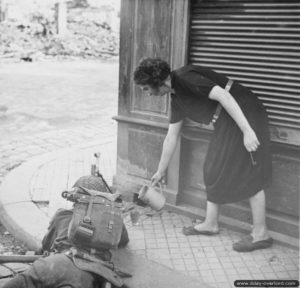Lisieux (Calvados)
The cities of Normandy during the 1944 battles
22 August 1944: a resident of Lisieux fills a glass for a soldier armed with a Bren gun.
Photo : IWM B9617
- Liberation: 23rd August 1944
- Deployed unity:
![]() 7th Armoured Division
7th Armoured Division
![]() 51st (Highland) Infantry Division
51st (Highland) Infantry Division
![]() 272. Infanterie-Division
272. Infanterie-Division
- History:
The joy at the announcement of the launch of Operation Overlord was short-lived for the people of Lisieux. On the night of 6 to 7 June 1944, almost eighty per cent of the town was destroyed by a series of Allied bombing raids. Lisieux was a major rail and road junction that the Germans could use to move their reinforcements towards the landing beaches. The first raid hit the eastern part of the town, particularly the station area, at 8.20 pm. At 1.20 am on 7 June, the bombers attacked the west of Lisieux for thirty minutes, also hitting the commune of Saint-Désir. The third and final raid turned the city centre into a field of ruins at 2pm. The survivors, fearing another bombardment, were reluctant to fight the fires raging through the town: the fire particularly consumed the historic quarter and its many half-timbered buildings dating from the medieval period. 819 inhabitants were killed and several thousand were left homeless. The days and weeks that followed were devoted to rescuing the victims and clearing the ruins. Some of the refugees found refuge in the crypt of the famous basilica, which was miraculously spared.
Faced with the Allied advance, the Germans blew up several bridges over the Touques at Lisieux on 28 and 29 July. However, this early destruction complicated their own withdrawal, which intensified from 4 August onwards: only a few roads were clear and they were unable to absorb all the vehicles fleeing eastwards.
Following the launch of Operation Paddle on 17 August, the Allied forces converged on the Seine in pursuit of the German divisions. Lisieux, whose ruins had been partly cleared to allow traffic along the main streets, remained an important military objective for all the belligerents despite its countless destructions. On the evening of 19 August, Major General Tom Rennie, commanding the 51st (Highland) Infantry Division, ordered the 154th Infrantry Brigade to reach the heights north-west of Lisieux and prepare to cross the Touques in this sector, while taking the town. At the same time, Major General Gerald Lloyd-Verney’s 7th Armoured Division in Livarot turned left towards Lisieux, to reach the heights south of the town. In preparation for this battle, Allied artillerymen opened fire on the slopes on both sides of the commune, and several shells ended their deadly curves in the rubble, devastating the area to no end. On the evening of 20 August, the “Desert Rats” of the 7th Armoured Division approached Saint-Martin-de-la-Lieue, while the Scots of the 51st Infantry Division caught sight of Saint-Pierre-des-Ifs. The next day, they reached the outskirts of Lisieux and began fighting against the front lines of the enemy’s defences.
Although the Germans were engaged in delaying action, some of them had retreated to the heights to the east of the Touques and systematically opened fire with their artillery on the slightest Allied movement approaching Lisieux. The ruins of the town were impregnable fortresses, either booby-trapped with explosives or battered by fire: to take them, you had to recognise this veritable labyrinth. On 22 August, the Germans destroyed the last remaining bridges and counter-attacked towards Saint-Martin-de-la-Lieue, inflicting heavy losses on the 1st Royal Tank Regiment and 4th County of London Yeomanry of the 22nd Armoured Brigade (7th Armoured Division).
But the British halted the German attack and regained the initiative, moving into the southern part of Lisieux. The Scots infiltrated from the west, crossing the Touques from makeshift bridges and using the intact railway viaduct. They reached the town centre near the ruins of Saint-Pierre-de-Lisieux cathedral and the railway station area. Street by street, quarter by quarter, ruin by ruin, the Allies drove back the defenders under constant German artillery and sniper fire.
In the late morning of 23 August, under constant pressure from the Anglo-Canadians, the Germans launched a desperate counter-attack from the north-east of Lisieux, from the woods of Rocques: despite heavy losses inflicted on the opposing side, the offensive was doomed to failure. French Resistance fighters had been spontaneously turning up to guide the British troops through the town for several days and were also taking part in the fighting. George Poilane, who had served in the French Navy at the start of the Second World War and joined the Resistance during the Occupation (obtaining the rank of captain in the Forces Françaises de l’Intérieur), was seriously wounded that day when he attacked a German machine gun.
The basilica fell into the hands of the 1st Battalion, The Gordon Highlanders (153rd Infantry Brigade, 51st (Highland) Infantry Division) before nightfall, soon reinforced by tanks from the 1st Royal Tank Regiment. The last defenders of Lisieux slipped out in the darkness towards Rocques and Hermival-les-Vaux. Generals Rennie and Lloyd-Verney were relieved to report the capture of the town after 36 hours of furious, uninterrupted fighting, but still feared a possible new enemy counterattack. After daybreak on August 24, the Germans had not launched a counteroffensive, and the Allies took stock of the fall of Lisieux. 51 Anglo-Canadian soldiers had been killed during the liberation of the town.
To facilitate the crossing of the Touques and the advance towards Evreux, the British sappers immediately installed a Bailey bridge to the west of the town centre and finished clearing mines from the roads crossing Lisieux, which were littered with unexploded munitions and various booby traps.
Lisieux map:

